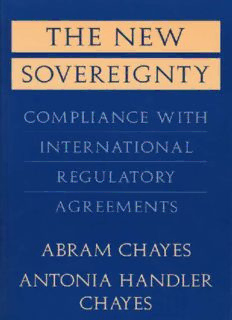
The New Sovereignty: Compliance with International Regulatory Agreements PDF
Preview The New Sovereignty: Compliance with International Regulatory Agreements
The New Sovereignty Compliance with International Regulatory Agreements Harvard University Press Cambridge, Massachusetts London, England 1995 Copyright1995byAbramChayesandAntoniaHandlerChayes Allrightsreserved PrintedintheUnitedStatesofAmerica LibraryofCongressCataloging-in-PublicationData Chayes,Abram,1922– Thenewsovereignty:compliancewithinternationalregulatory agreements/AbramChayes,AntoniaHandlerChayes. p. cm. Includesbibliographicalreferencesandindex. ISBN0-674-61782-7(cloth:alk.paper) 1.Treaties. 2.Compliance. 3.Sovereignty. I.Chayes,AntoniaHandler,1929– . II.Title. JX4165.C43 1995 341.3′7—dc20 95-21960 To each other Contents Preface ix 1 A Theory of Compliance 1 Sanctions 29 2 Treaty-Based Military and Economic Sanctions 34 3 Membership Sanctions 68 4 Unilateral Sanctions 88 Toward a Strategy for Managing Compliance 109 5 Norms 112 6 Transparency, Norms, and Strategic Interaction 135 7 Reporting and Data Collection 154 8 Verification and Monitoring 174 9 Instruments of Active Management 197 10 Policy Review and Assessment 229 11 Nongovernmental Organizations 250 12 Revitalizing International Organizations 271 Appendix: List of Treaties 287 Notes 303 Index 405 Preface Wedidnotstartouttowritethisbook.Westartedouttoteachtogether.The only area in which we both had professional qualifications was arms con- trol—Abe, starting in 1963 as Legal Adviser to the State Department, was involved in the Limited Test Ban Treaty, and Toni, as Undersecretary of the Air Force in the Carter administration, was involved in the MX missile deployment. Our course, ‘‘Law, Doctrine, and Politics in Nuclear Weapons Management,’’whichwetaughtformorethanadecade,increasinglyfocused on the question of why, in an environment of inveterate ideological con- frontation, mutual suspicion, and hostility, the two superpowers continu- ously sought to negotiate arms control agreements—and substantially complied with the obligations they assumed. This question seemed to grow somewhat less urgent with the end of the cold war and the dissolution of the Soviet Union. So we began to ask our- selveswhethersomeofthethingswehadlearnedwouldbeapplicabletothe problem of treaty compliance in general. In particular, we had been impressed with the work of a little-known body, the Standing Consultative Commission (), established by the agreements to ‘‘consider ques- tions concerning compliance with the obligations assumed and related sit- uations which may be considered ambiguous.’’ It is perhaps not surprising that, as lawyers, we assumed that the question of compliance with legal obligations would have something to do with the institutions for the settle- ment of disputes about their interpretation and application. The was interestingbecause,althoughithadnoadjudicativeorenforcementauthority andwaslittlemorethananegotiatingforum,itwastheinstrumentthrough which some important issues between the treaty parties were resolved, even
Description: